service indicator BUICK CENTURY 1996 Owners Manual
[x] Cancel search | Manufacturer: BUICK, Model Year: 1996, Model line: CENTURY, Model: BUICK CENTURY 1996Pages: 340, PDF Size: 17.61 MB
Page 112 of 340
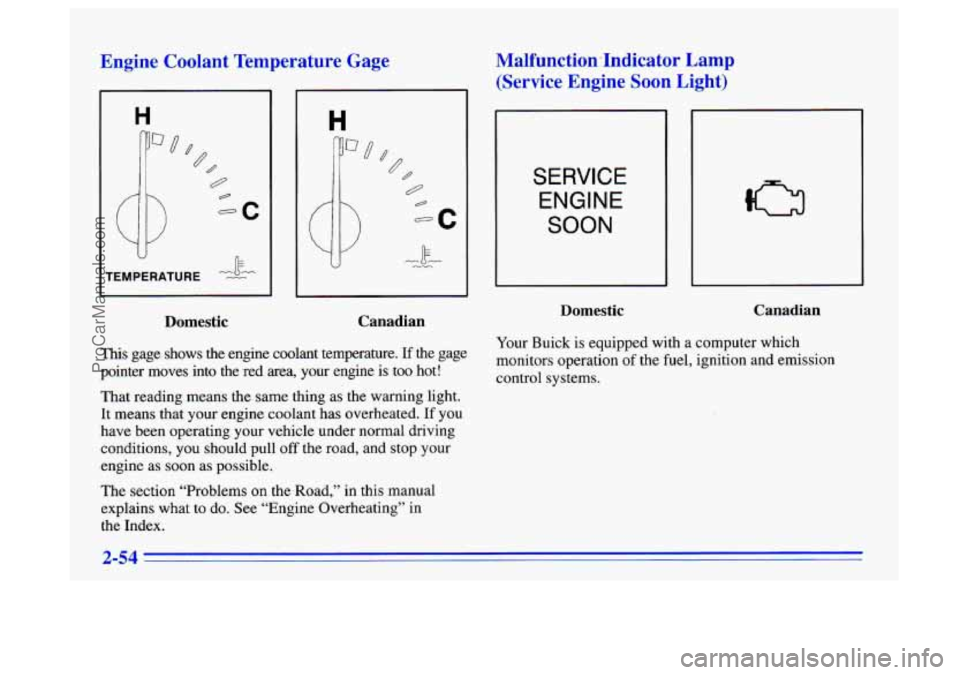
Engine Coolant Temperature Gage
II k
TEMPERATURE -Z
Domestic Canadian
This
gage shows the engine coolant temperature. If the gage
pointer moves into the red area, your engine is too hot!
That reading means the same thing
as the warning light.
It means that your engine coolant has overheated. If you
have been operating your vehicle under normal driving
conditions, you should pull off the road, and stop your
engine as soon as possible.
The section “Problems on the Road,” in this manual
explains what to do. See “Engine Overheating” in
the Index.
Malfunction.Indicator Lamp
(Service Engine Soon Light)
SERVICE
ENGINE
SOON
Domestic Canadian
Your
Buick is equipped with a computer which
monitors operation
of the fuel, ignition and emission
control systems.
2-54
ProCarManuals.com
Page 117 of 340
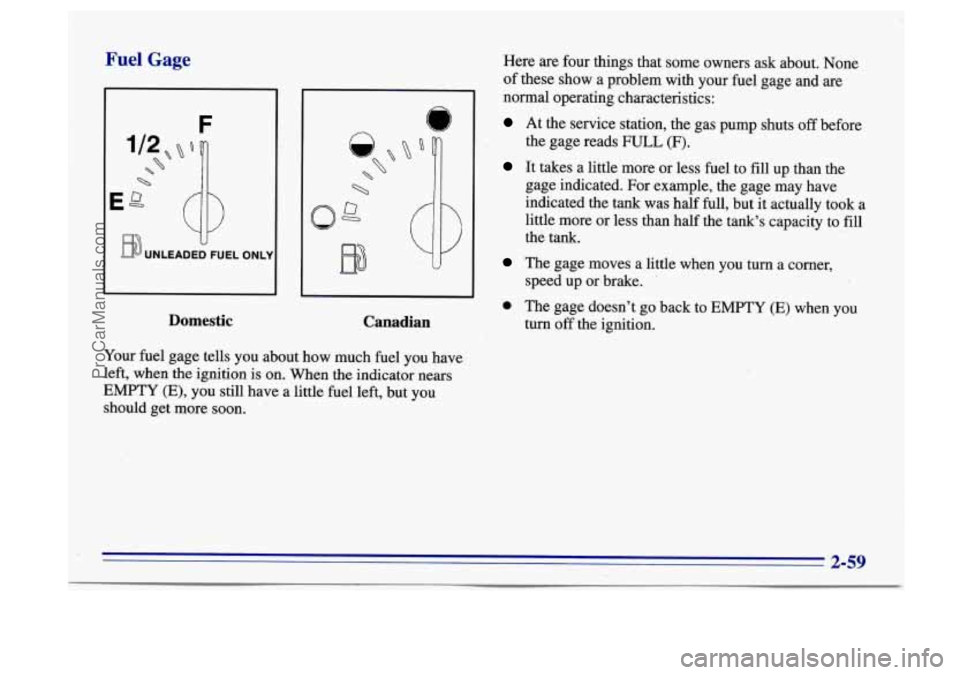
Fuel Gage
Eg 0
BUNLEADED FUEL ONLY
II
Domestic Canadian
Your fuel gage tells you about how much fuel you have
left, when the ignition is on. When the indicator nears
EMPTY (E), you still have a little fuel left, but you
should get more soon. Here are four
things that some owners ask about. None
of these show a problem with your fuel gage and
are
normal operating characteristics:
At the service station, the gas pump shuts off before
the gage reads FULL (F).
It takes a little more or less fuel to fill up than the
gage indicated. For example, the gage may have
indicated the tank was half full, but it actually took
a
little more or less than half the tank's capacity to fill
the tank.
The gage moves a little when you turn a corner,
0 The gage doesn't go back to EMPTY (E) when you
speed
up or brake.
turn
off the ignition.
I
2-59
ProCarManuals.com
Page 209 of 340
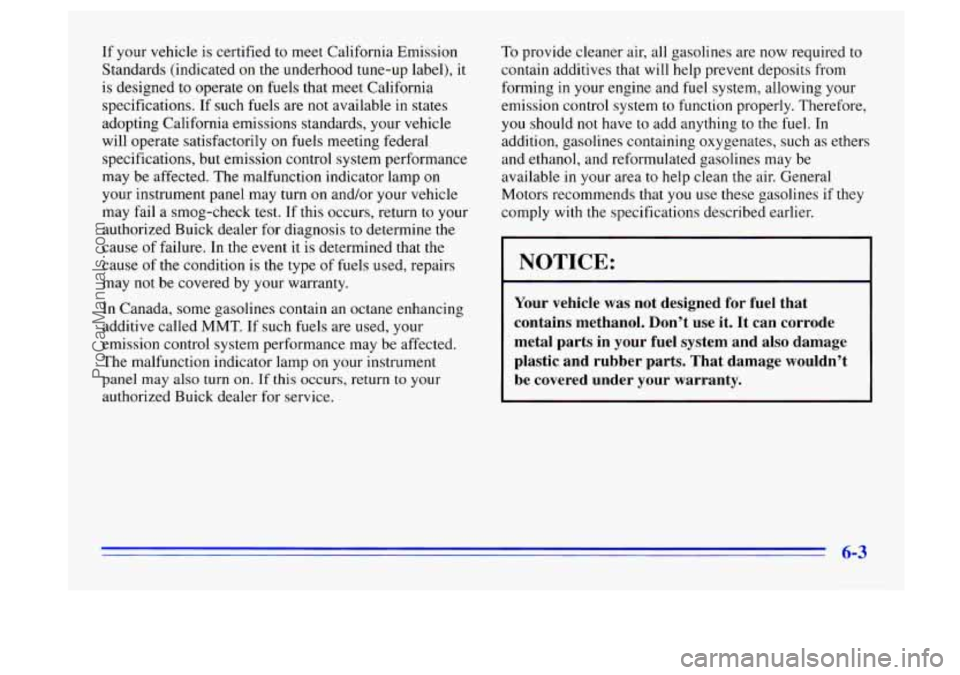
If your vehicle is certified to meet California Emission
Standards (indicated on the underhood tune-up label), it
is designed
to operate on fuels that meet California
specifications. If such fuels are not available
in states
adopting California emissions standards, your vehicle
will operate satisfactorily on fuels meeting federal
specifications, but emission control system performance
may be affected.
The malfunction indicator lamp on
your instrument panel may turn on and/or your vehicle
may fail
a smog-check test. If this occurs, return to your
authorized Buick dealer for diagnosis to determine the
cause of failure. In the event it is determined that the
cause of the condition is the type
of fuels used, repairs
may not be covered by your warranty.
In Canada, some gasolines contain an octane enhancing
additive called MMT.
If such fuels are used, your
emission control system performance may be affected.
The malfunction indicator lamp on your instrument
panel may also turn on. If this occurs, return to your
authorized Buick dealer for service.
To provide cleaner air, all gasolines are now required to
contain additives that will help prevent deposits from
forming
in your engine and fuel system, allowing your
emission control system to function properly. Therefore,
you should not have to add anything to the fuel. In
addition, gasolines containing oxygenates, such
as ethers
and ethanol, and reformulated gasolines may be
available
in your area to help clean the air. General
Motors recommends that you use these gasolines
if they
comply with the specifications described earlier.
I NOTICE:
Your vehicle was not designed for fuel that
contains methanol. Don’t use it. It can corrode
metal parts in your fuel system and also damage
plastic and rubber parts. That damage wouldn’t
be covered under your warranty.
6-3
ProCarManuals.com
Page 237 of 340
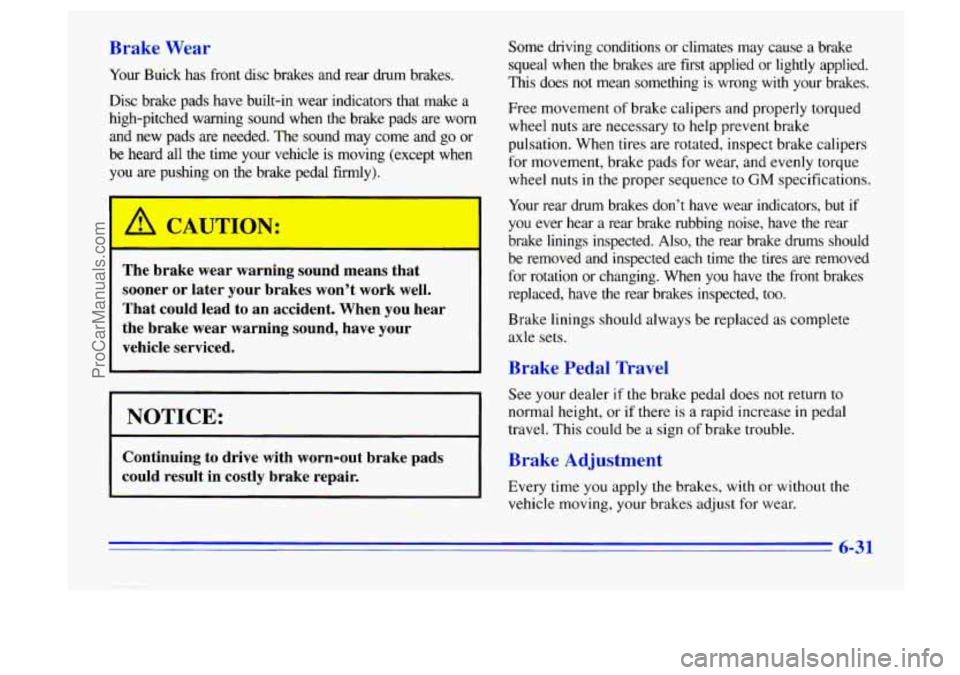
Brake Wear
Your Buick has front disc brakes and rear drum brakes.
Disc brake pads have built-in wear indicators that make a
high-pitched warning sound when the brake pads are worn
and new pads are needed.
The sound may come and go or
be heard all
the time your vehicle is moving (except when
you are pushing on the brake pedal firmly).
A CAUTION:
The brake wear warning sound means that
sooner or later your brakes won’t work well.
That could lead to an accident. When you hear
the brake wear warning sound, have your
vehicle serviced.
NOTICE:
Continuing to drive with worn-out brake pads
could result in costly brake repair.
Some driving conditions or climates may cause a brake
squeal when the brakes are first applied or lightly applied.
This does not mean something
is wrong with your brakes.
Fre’- -1ovement
of brake calipers and properly torqued
wheel nuts are necessary to help prevent brake
pulsation. When tires are rotated, inspect brake calipers
for movement, brake pads for wear, and evenly torque
wheel nuts
in the proper sequence to GM specifications.
Your rear drum brakes don’t have wear indicators, but
if
you ever hear a rear brake rubbing noise, have the rear
brake linings inspected.
Also, the rear brake drums should
be removed and inspected each time the tires are removed
for rotation or changing. When you have the front brakes
replaced, have
the rear brakes inspected, too.
Brake linings should always be replaced as complete
axle sets.
Brake Pedal Travel
See your dealer if the brake pedal does not return to
normal height, or if there is
a rapid increase in pedal
travel. This could be
a sign of brake trouble.
Brake Adjustment
Every time you apply the brakes, with or without the
vehicle moving, your brakes adjust for wear.
6-31
ProCarManuals.com
Page 247 of 340
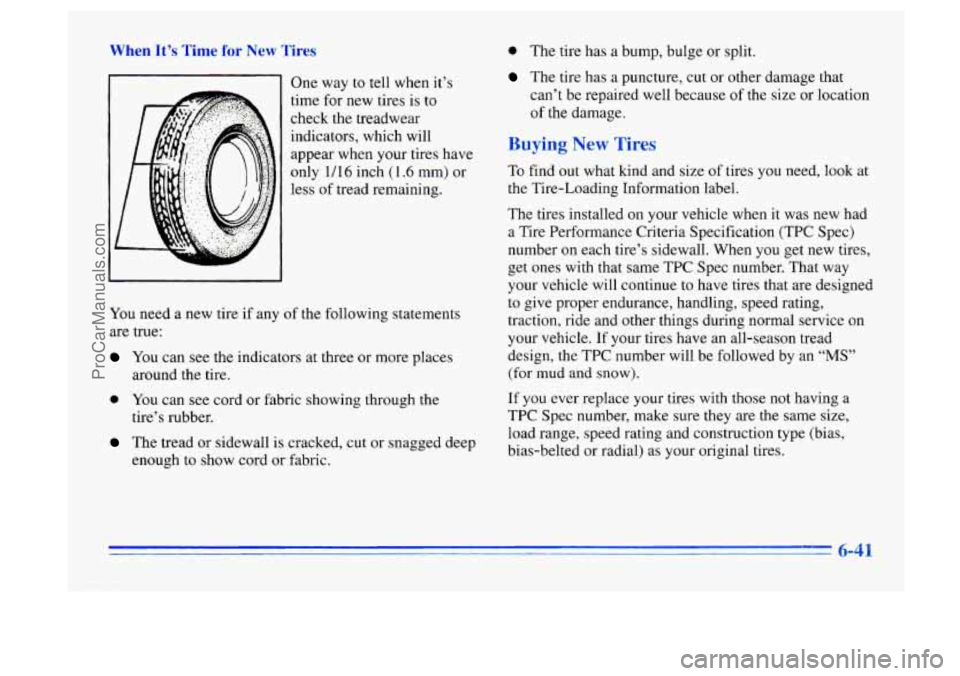
When It’s Time for New Tires
I1 One way to tell when it’s d
time for new tires is to
check the treadwear
indicators, which will
appear when your tires have
only
1/16 inch (1.6 mm) or
less of tread remaining.
You need a new tire if any of the following statements
are true:
You can see the indicators at three or more places
around the tire.
0 You can see cord or fabric showing through the
tire’s rubber.
The tread or sidewall is cracked, cut or snagged deep
enough to show cord or fabric.
0 The tire has a bump, bulge or split.
The tire has a puncture, cut or other damage that
can’t be repaired well because of the size or location
of the damage.
Buying New Tires
To find out what kind and size of tires you need, look at
the Tire-Loading Information label.
The tires installed on your vehicle when it was new had
a Tire Performance Criteria Specification
(TPC Spec)
number on each tire’s sidewall. When you get new tires,
get ones with that same TPC Spec number. That way
your vehicle will continue to have tires that are designed
to give proper endurance, handling, speed rating,
traction, ride and other things during normal service on
your vehicle. If your tires have an all-season tread
design, the TPC number will be followed by an
“MS”
(for mud and snow).
If you ever replace your tires with those not having a
TPC Spec number, make sure they are the same size,
load range, speed rating
and construction type (bias,
bias-belted
or radial) as your original tires.
5-41
ProCarManuals.com
Page 334 of 340
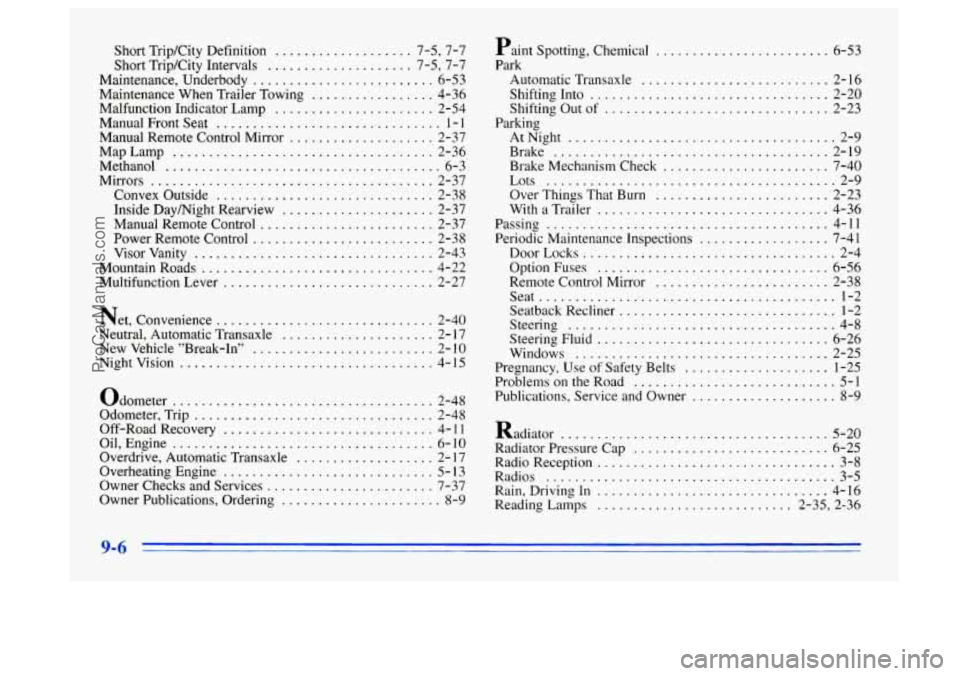
Short TripKity Definition ................... 7.5, 7.7
Short Trip/City Intervals
.................... 7.5. 7.7
Maintenance. Underbody
......................... 6-53
Maintenance When Trailer Towing
................. 4-36
Malfunction Indicator Lamp
...................... 2-54
Manual Front Seat
............................... 1 - 1
Manual Remote Control Mirror .................... 2-37
MapLamp
.................................... 2-36
Methanol
...................................... 6-3
Mirrors
....................................... 2-37
Convex Outside
.............................. 2-38
Inside Daymight Rearview
..................... 2-37
Manual Remote Control
........................ 2-37
Power Remote Control
......................... 2-38
Visor Vanity
................................. 2-43
MountainRoads
................................ 4-22
Multifunction Lever
............................. 2-27
Net. Convenience
.............................. 2-40
Neutral. Automatic Transaxle
..................... 2- 17
New Vehicle "Break-In"
......................... 2- 10
Nightvision ................................... 4-15
Odometer .................................... 2-48
Odometer. Trip
................................. 2-48
Off-Road Recovery
............................. 4- 1 1
Oil. Engine .................................... 6-10
Overdrive. Automatic Transaxle
................... 2- 17
Overheating Engine ............................. 5 - 13
Owner Checks and Services
....................... 7-37
Owner Publications. Ordering
...................... 8-9
Paint Spotting. Chemical ........................ 6-53
Park Automatic Transaxle
.......................... 2-16
Shifting Into ................................. 2-20
Shifting Out of
............................... 2-23
AtNight
..................................... 2-9
Brake
...................................... 2-19
Brake Mechanism Check
....................... 7-40
Lots
........................................ 2-9
Over Things That Burn
........................ 2-23
With
a Trailer ................................ 4-36
Passing
....................................... 4-11
Periodic Maintenance Inspections .................. 7-41
DoorLocks
................................... 2-4
Option Fuses
................................ 6-56
Remote Control Mirror ........................ 2-38
Seat
......................................... 1-2
Seatback Recliner
.............................. 1-2
Steering
..................................... 4-8
Steering Fluid
................................ 6-26
Windows
................................... 2-25
Pregnancy. Use
of Safety Belts .................... 1-25
Problems on
the Road ............................ 5-1
Publications, Service and Owner .................... 8-9
Parking
Radiator
..................................... 5-20
Radiator Pressure Cap
........................... 6-25
Radio Reception
................................. 3-8
Radios ........................................ 3-5
Rain. Driving In ................................ 4-16
Reading Lamps
........................... 2-35. 2.36
9-6
ProCarManuals.com
Page 338 of 340
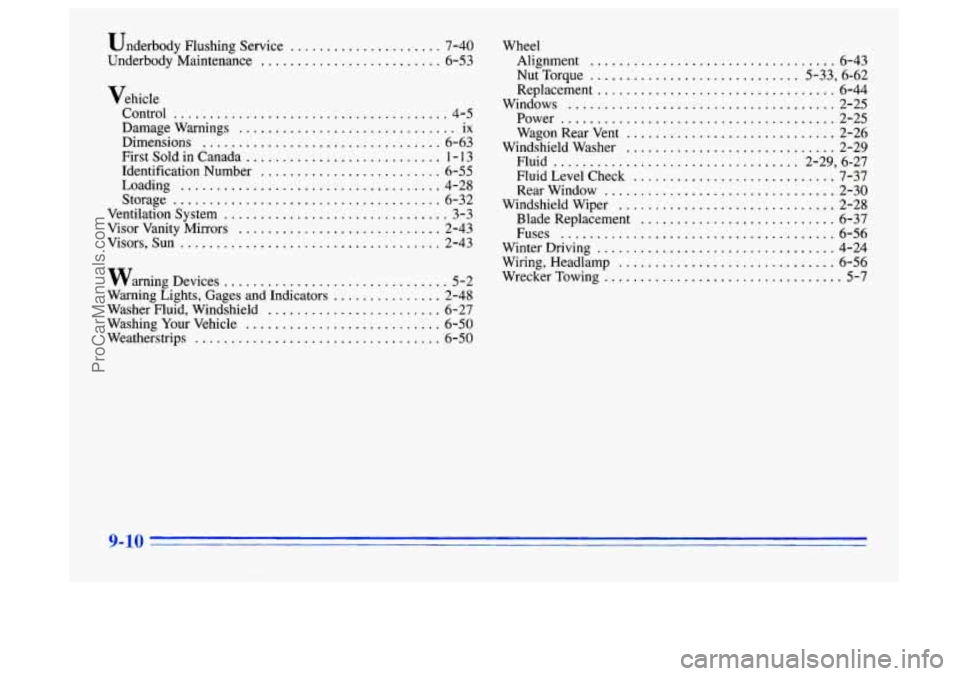
Underbody Flushing Service ..................... 7-40
Underbody Maintenance ......................... 6-53
Vehicle
Control
...................................... 4-5
Damage Warnings .............................. ix
Dimensions
................................. 6-63
First Sold in Canada ........................... 1 - 13
Identification Number ......................... 6-55
Loading .................................... 4-28
Storage ..................................... 6-32
Ventilation System ............................... 3-3
Visor Vanity Mirrors ............................ 2-43
Visors. Sun .................................... 2-43
warning Devices ............................... 5-2
Warning Lights. Gages and Indicators ............... 2-48
Washer Fluid. Windshield ........................ 6-27
Washing Your Vehicle ........................... 6-50
Weatherstrips .................................. 6-50
Wheel
Alignment
.................................. 6-43
Nut Torque ............................. 5.33. 6.62
Replacement ................................. 6-44
Windows ..................................... 2-25
Power ...................................... 2-25
Wagon Rear Vent .............................. 2-26
Windshield Washer ............................. 2-29
Fluid .................................. 2-29. 6.27
Fluid Level Check ............................ 7-37
Rearwindow ................................ 2-30
Windshield Wiper .............................. 2-28
Blade Replacement ........................... 6-37
Winter Driving ................................. 4-24
Wiring, Headlamp .............................. 6-56
WreckerTowing ................................. 5-7
Fuses ...................................... 6-56
9-10
ProCarManuals.com